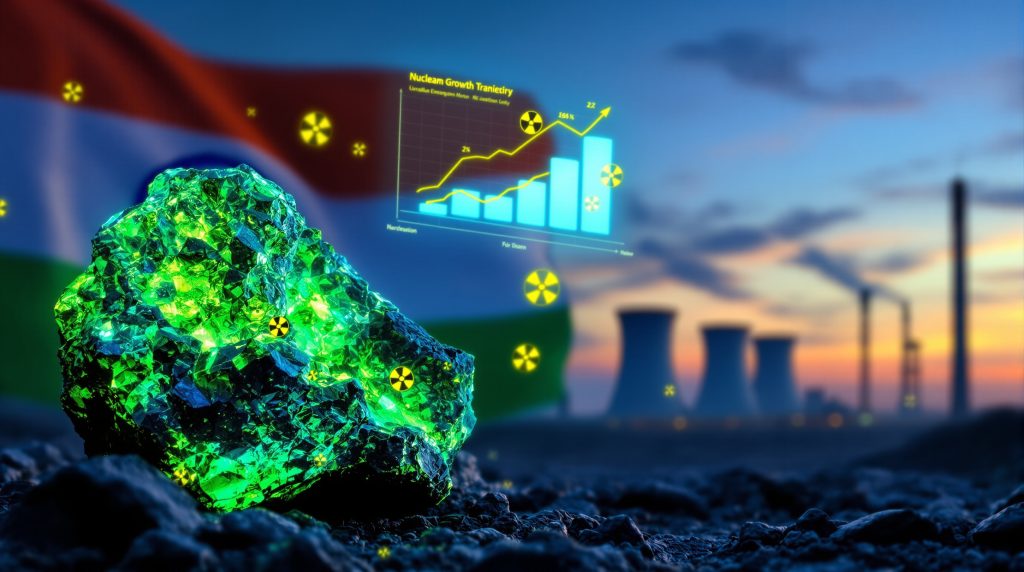Hindustan Zinc's Uranium Mining Ambitions: Transforming India's Nuclear Landscape
India's nuclear energy sector is on the brink of a significant transformation as Hindustan Zinc, the country's leading zinc producer, positions itself to enter uranium mining. This strategic move aligns with the government's plans to end its decades-old state monopoly on uranium mining and processing, potentially revolutionizing India's energy landscape and critical minerals strategy.
Hindustan Zinc's Strategic Pivot to Uranium Mining
Hindustan Zinc, renowned for its dominance in India's zinc production, has publicly expressed its intention to diversify into uranium mining. This move represents a significant shift in the company's strategic direction and could mark a turning point in India's nuclear fuel supply chain.
"If new uranium blocks are put out for private companies, Hindustan Zinc will be the first to bid," stated Arun Misra, CEO of Hindustan Zinc, underlining the company's commitment to entering this strategic sector. "We will get into atomic minerals and especially uranium because the country needs it," he added, highlighting both commercial and national interest motivations.
The company aims to leverage its extensive mining expertise, established infrastructure, and operational capabilities to gain a competitive advantage in this newly opening sector. As a seasoned mining operation with decades of experience extracting and processing metals, Hindustan Zinc believes its technical knowledge provides a strong foundation for uranium operations.
Potential timeline and approach
While specific details remain contingent on government policy changes, industry analysts suggest Hindustan Zinc would likely implement a phased approach:
- Initial exploration and resource assessment phase
- Feasibility studies and environmental impact assessments
- Mining infrastructure development
- Processing facility construction
- Full-scale production ramp-up
This process could span 5-7 years from regulatory approval to commercial production, though the timeline depends heavily on the speed of government reforms and the specific characteristics of allocated uranium blocks.
India's Shifting Uranium Mining Policy Landscape
The Indian government's consideration of private sector participation in uranium mining represents a fundamental shift in national policy that has maintained strict state control over nuclear materials for decades.
Historical context and current monopoly
Historically, India has maintained tight governmental control over uranium mining, processing, and importation through entities like the Uranium Corporation of India Limited (UCIL). This monopoly stemmed from strategic security concerns, safety considerations, and international non-proliferation commitments.
The restrictive policy has created several challenges:
- Limited exploration and production capacity
- Constrained nuclear power development
- Heavy reliance on uranium imports
- Technological limitations in mining and processing
Modi's nuclear vision driving policy reform
Prime Minister Narendra Modi's government has articulated an ambitious vision to expand India's nuclear power capacity 12-fold by 2047. This dramatic scaling requires a corresponding increase in uranium supply that the current state monopoly structure struggles to support.
The proposed policy reforms aim to:
- End decades-old state monopoly over the nuclear sector
- Create a framework for private sector participation
- Attract billions of dollars in investment
- Accelerate domestic uranium production
- Reduce import dependence on foreign uranium
Industry perspective: The policy shift represents perhaps the most significant change in India's nuclear sector governance since the 2008 U.S.-India Civil Nuclear Agreement that ended India's nuclear isolation.
These reforms, while maintaining appropriate safety and security oversight, could dramatically accelerate India's nuclear power development trajectory.
Transforming India's Energy Security Through Private Uranium Mining
The entry of private companies like Hindustan Zinc into uranium mining could fundamentally reshape India's energy security position and nuclear power capabilities.
Current nuclear capacity constraints
India's nuclear power program has historically faced significant constraints due to limited domestic uranium supplies and, until recently, restrictions on international uranium imports. These limitations have:
- Kept nuclear's contribution to the national energy mix below 3%
- Resulted in underutilized nuclear plant capacity
- Created vulnerability to supply disruptions
- Limited expansion of nuclear generation
Potential impact of increased domestic production
Private sector participation could dramatically increase domestic uranium production through:
- Expanded exploration of previously unassessed areas
- Introduction of advanced mining technologies
- More efficient extraction and processing methods
- Greater capital investment in production capacity
This production increase would support India's ambitious nuclear expansion plans while reducing vulnerability to international supply disruptions or price volatility.
Energy security implications
Enhanced domestic uranium production offers several strategic benefits:
- Reduced dependence on uranium imports from countries like Kazakhstan, Canada, and Russia
- Increased energy sovereignty and supply chain resilience
- Greater price stability for nuclear fuel
- More predictable nuclear plant operations and output
Hindustan Zinc's Comprehensive Critical Minerals Strategy
Hindustan Zinc's interest in uranium represents just one component of a broader strategic pivot toward critical minerals essential for energy transition technologies and national security applications.
Rare earth elements development
The company has already taken concrete steps in rare earth elements (REEs):
- Won its first rare earth block in Uttar Pradesh earlier in 2025
- Initiated global tenders for exploration partners
- Projects neodymium production within 5-6 years
- Targets magnets for motors and generators markets
"We expect to start extracting neodymium – a rare earth used in magnets for motors and generators – in five to six years," noted CEO Arun Misra, highlighting the company's long-term vision for this strategic mineral.
Diversified critical minerals portfolio
Beyond uranium and rare earths, Hindustan Zinc has expressed interest in several other critical minerals:
- Lithium: Essential for battery technologies and energy storage
- Antimony: Used in flame retardants, batteries, and semiconductor manufacturing
- Germanium: Critical for fiber optics, infrared optics, and electronics
- Copper: Fundamental to electrical infrastructure and renewable energy systems
- Graphite: Key component in battery anodes and various industrial applications
This diversification strategy positions the company to support multiple strategic sectors, from clean energy to defense applications.
Strategic international partnerships
To accelerate its critical minerals development, Hindustan Zinc is actively seeking international partnerships:
- Australian companies with expertise in uranium and rare earth mining
- South African firms with deep mining experience
- Latin American partners from Peru and Chile with lithium expertise
- Potential Chinese collaborations despite geopolitical complexities
These partnerships would provide access to specialized technical knowledge, exploration capabilities, and processing technologies essential for successfully developing these complex mineral resources.
India-China Critical Minerals Dynamics and Implications
Hindustan Zinc's expansion into uranium mining occurs against the backdrop of complex India-China relations in the critical minerals space, featuring both competitive and cooperative elements.
Recent supply chain disruptions
The fragility of global critical minerals supply chains was starkly demonstrated in April 2025 when China, which controls the bulk of global rare earth mining, suspended exports of a wide range of rare earths and related magnets. This action caused significant disruptions across multiple industries:
- Automotive manufacturing delays
- Aerospace production interruptions
- Semiconductor supply chain challenges
- Clean energy project postponements
These disruptions highlighted India's vulnerability to critical mineral supply chain dependencies.
Diplomatic developments and strategic realignment
Recent diplomatic engagement between India and China has produced tentative progress on rare earth access:
- Beijing has promised to address New Delhi's rare earth needs
- Bilateral discussions focus on critical minerals trade normalization
- Gradual rebuilding of economic ties following the 2020 border clash
- Potential for controlled cooperation in specific mineral sectors
Despite these diplomatic overtures, India continues to pursue supply chain resilience through domestic production development, including Hindustan Zinc's initiatives.
Strategic balancing act
India faces a delicate balancing act in its critical minerals relationship with China:
- Maintaining access to Chinese expertise and technology
- Reducing dependency on Chinese supplies through domestic alternatives
- Leveraging international partnerships to diversify supply chains
- Developing indigenous capabilities across the mineral value chain
This strategic context makes Hindustan Zinc's diversification particularly significant for national security considerations.
Hindustan Zinc's Core Business Expansion Plans
While pursuing diversification into uranium and other critical minerals, Hindustan Zinc remains committed to substantial growth in its traditional zinc business.
Ambitious zinc production targets
The company has announced plans for "doubling its production capacity to 2 million metric tons by 2029," representing one of the most significant expansion programs in the global zinc industry. This growth trajectory will:
- Strengthen its position as India's dominant zinc producer
- Increase its global market share and influence
- Generate capital to fund diversification initiatives
- Create economies of scale for more efficient operations
Market positioning strategy
This dual-track approach—growing the core zinc business while diversifying into strategic minerals—represents a sophisticated strategic approach:
- Leverages established operational expertise and infrastructure
- Balances stable revenue streams with higher-risk, higher-reward opportunities
- Addresses both commercial objectives and national strategic needs
- Positions the company for leadership in multiple mineral markets
Regulatory Hurdles for Private Uranium Mining
For Hindustan Zinc's uranium ambitions to materialize, significant regulatory reforms must occur to open India's tightly controlled nuclear sector to private participation.
Required legislative changes
The cornerstone of India's nuclear regulatory framework, the Atomic Energy Act of 1962, would require substantial amendments to enable private uranium mining:
- Modification of provisions restricting uranium mining to government entities
- Creation of licensing frameworks for private operators
- Establishment of oversight mechanisms for private operations
- Development of safety and security protocols
Nuclear regulatory considerations
Even with legislative changes, uranium mining would remain subject to extensive regulatory oversight:
- Atomic Energy Regulatory Board supervision
- International Atomic Energy Agency safeguards compliance
- Specialized environmental permitting requirements
- Stringent radiation safety management protocols
Security and non-proliferation safeguards
The government would need to develop robust security frameworks to address:
- Physical security of nuclear materials
- Accounting and tracking systems for uranium
- Export controls and transfer restrictions
- Non-proliferation commitment compliance
Environmental and Social Dimensions of Uranium Mining
Any uranium mining operation by Hindustan Zinc would need to address significant environmental and social considerations unique to this sector.
Specialized environmental management requirements
Uranium mining presents distinct environmental challenges compared to conventional mining:
- Radioactive waste management systems
- Tailings containment and monitoring
- Groundwater protection measures
- Dust control and radiation exposure prevention
- Long-term site remediation planning
Community engagement imperatives
Successful uranium mining operations require exceptional community engagement:
- Transparent communication about safety measures
- Community benefit-sharing arrangements
- Local employment and training programs
- Health monitoring and protection initiatives
Sustainable practices integration
Modern uranium mining increasingly incorporates sustainable practices:
- Water recycling and conservation techniques
- Energy efficiency and renewable power integration
- Biodiversity protection and enhancement
- Progressive rehabilitation during operations
Addressing these concerns requires a comprehensive uranium environmental policy framework that balances resource development with ecological protection.
Global Market Implications of India's Uranium Mining Expansion
The entry of Indian private companies into uranium mining could have several implications for global uranium markets and nuclear fuel supply chains.
Potential market impact assessment
While India's uranium resources are modest compared to major producers like Kazakhstan, Canada, and Australia, private sector development could:
- Increase global uranium exploration investment
- Introduce new supply sources to international markets
- Potentially influence long-term pricing dynamics
- Create new international partnership opportunities
Recent uranium market volatility has highlighted the need for diversified supply sources, making India's potential contribution particularly relevant to global market stability.
International nuclear cooperation dimensions
India's uranium mining expansion would occur within the context of its evolving international nuclear cooperation framework:
- Nuclear Suppliers Group relationships
- Bilateral nuclear cooperation agreements
- International safety and security commitments
- Non-proliferation treaty considerations
Furthermore, lessons from recent US uranium disruption scenarios demonstrate the importance of building resilient supply chains with multiple source countries.
Technical Challenges in Uranium Mining Operations
Despite its mining expertise, Hindustan Zinc would face several significant technical challenges in establishing uranium operations.
Specialized mining requirements
Uranium mining involves unique technical considerations:
- Radiation monitoring and protection systems
- Specialized ventilation requirements
- Dust suppression and containment
- Worker health surveillance programs
Learning from historical uranium mining cases would be essential for Hindustan Zinc to develop effective operational protocols.
Processing complexities
The extraction and processing of uranium ore presents distinct challenges:
- Complex hydrometallurgical processing circuits
- Strict quality control requirements
- Specialized waste management systems
- Regulatory compliance documentation
Skilled workforce development
Successful uranium mining operations require specialized expertise:
- Radiation safety professionals
- Nuclear material handling specialists
- Environmental monitoring technicians
- Regulatory compliance officers
FAQ: Hindustan Zinc and Uranium Mining
What experience does Hindustan Zinc have with nuclear minerals?
While Hindustan Zinc lacks direct uranium mining experience, the company brings relevant transferable expertise:
- Decades of underground mining operations
- Complex ore processing experience
- Environmental management systems
- Regulatory compliance frameworks
However, uranium mining would require additional specialized knowledge acquisition through partnerships, hiring, and training.
How long would it take to develop a uranium mine in India?
The development timeline for a new uranium mine typically spans 5-7 years from regulatory approval to production:
- Exploration and resource definition: 1-2 years
- Feasibility studies and permitting: 1-2 years
- Mine development and construction: 2-3 years
- Commissioning and ramp-up: 6-12 months
This timeline could be extended by regulatory complexities specific to uranium.
What safety measures are required for uranium mining?
Uranium mining safety systems are comprehensive and multi-layered:
- Continuous radiation monitoring networks
- Specialized personal protective equipment
- Enhanced ventilation systems
- Regular worker health assessments
- Strict access control and material tracking
- Emergency response capabilities
- Environmental monitoring programs
How might uranium mining affect Hindustan Zinc's market valuation?
The market impact of uranium diversification could be significant:
- Strategic diversification premium potential
- Increased revenue stream diversity
- Higher growth trajectory projections
- Enhanced alignment with national priorities
However, investors would also consider increased regulatory complexity, longer development timelines, and specialized operational risks when developing uranium investment strategies.
What role will international cooperation play in India's uranium development?
International cooperation will be essential across multiple dimensions:
- Technology transfer arrangements
- Technical expertise acquisition
- Best practices implementation
- Safety and security protocols
- Environmental management systems
- Regulatory framework development
Conclusion: A Transformative Opportunity with Complex Challenges
Hindustan Zinc's potential expansion into uranium mining represents a transformative opportunity for both the company and India's energy landscape. By leveraging its mining expertise while developing specialized capabilities for uranium operations, the company could play a pivotal role in supporting India's ambitious nuclear power expansion goals.
The success of this initiative depends on effective navigation of complex regulatory, technical, and environmental challenges unique to uranium mining. With appropriate partnerships, investment, and regulatory frameworks, private uranium mining could significantly enhance India's energy security while creating new value for Hindustan Zinc shareholders.
As India's government considers ending its state monopoly on uranium mining, the coming years will reveal whether this bold vision for private sector participation in the nuclear fuel cycle will materialize, potentially reshaping the country's energy future for decades to come.
Ready to Stay Ahead of Major Mineral Discoveries?
Don't miss the next transformative ASX mining announcement like Hindustan Zinc's uranium ambitions. Discovery Alert's proprietary Discovery IQ model delivers instant notifications on significant mineral discoveries, turning complex data into actionable investment insights before the broader market catches on. Explore historic discovery returns at https://discoveryalert.com.au/discoveries/ and position yourself for early investment opportunities.




